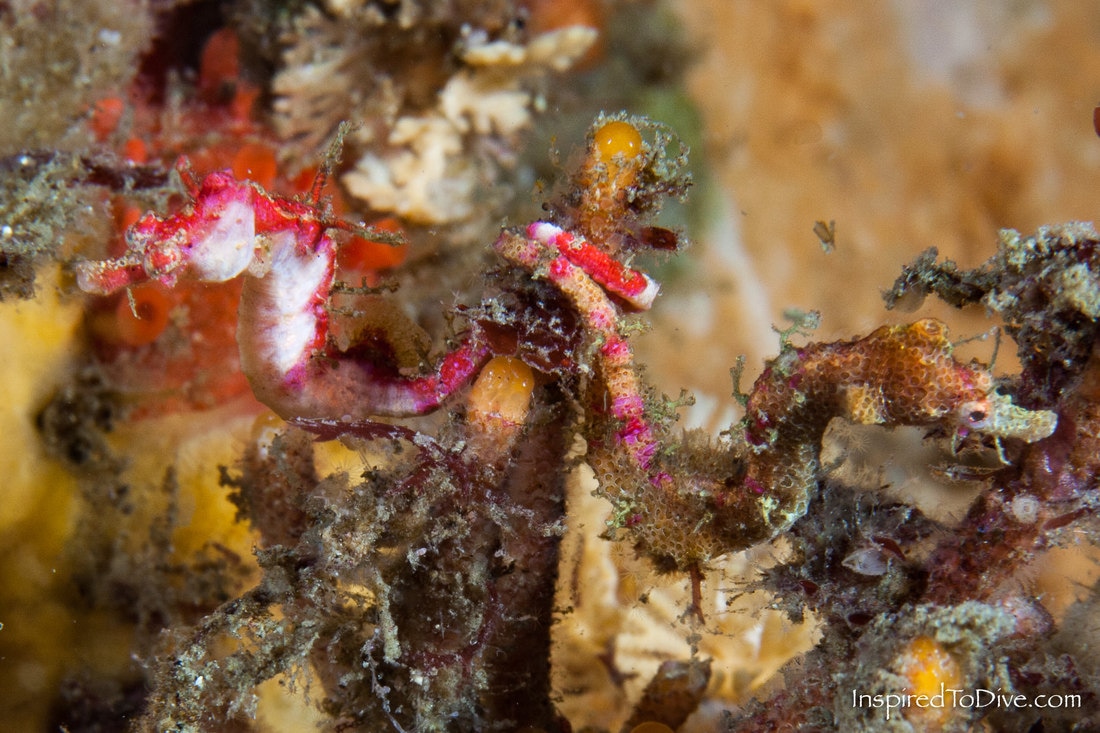I was enjoying a special Northland Waitangi Day in my own tradition - scuba diving. Drifting around underwater, I got to check in with a lot of my favourite fishes: red moki, blue maomao, grey moray, demoiselles and kingfish. I was in my happy place.
The topography of the rocky reef lead me into a gully with a vertical wall on one side. I decided to spend the final minutes of my dive searching for nudibranchs, the colourful sea slugs that bling up the underwater world.
I tried to take a couple of photos. The sea horse was shy, it turned away from me and my underwater flashes. I wanted to get a good identifying shot because the sea horse didn’t look like any sea horse I’d ever seen in New Zealand before. The bright pink colouration with patches of white, the back tassels, the diminutive size - I’d never seen anything like it. Then I realised there were two!
Where one of the pair was intensely pink-red, the other was brown, mottled and muted. It was all but invisible on the silt-covered wall. I checked my dive computer; I didn’t have much time. My boat skipper Shane from Northland Dive was going to be expecting me back at the boat any minute now. I tried again to get some shots, frustration mounting. Normally I wouldn’t persist with such a shy animal, but this was necessary for identification purposes. All I was getting were some nice photos of the back of their heads!
Less than one year later a photo of another unusual sea horse was posted on Facebook. The discovery was made by Justin Ricketts and the photo was taken by Kent Ericksen of Oceanblue Adventures at the Poor Knights Islands. The report says there were two animals, tails intertwined – just like my sighting. The photo showed similarities with the photos I had taken, particularly the cup-shaped hump on the head and colour (note colouration can be highly variable and is not necessarily an identifying feature).
I phoned sea horse expert Chris Woods from NIWA. I explained what I had seen and he said it sounded like a pygmy pipehorse. I thought I must have heard him wrong. I knew of sea horses, and pipefish, but a pipehorse – now that was a new one to me! I emailed photos and he came back to me: “your pygmy pipehorse looks very much like Acentronura australe known from one specimen from the Bay of Islands, but as we have very limited knowledge of this group (especially from NZ) pinning it down to species is difficult”.
I have so many questions and very little is clear. Is this species rare, or rarely seen, or both? Clearly this little guy is rocking some killer camouflage – we call it cryptic. To say that this animal could be easily overlooked by divers would be an understatement. To learn more we need all keen underwater eyes on the hunt for this species. Stay tuned...
Many thanks to Julia Riddle and Shane Housham from Northland Dive who allow me to do the long dive times that make these discoveries possible.
Thanks to Shane Housham for contributing images to assist in the identification of the pygmy pipehorses.
Thanks to Chris Woods from NIWA and Andrew Stewart from Te Papa for their expert opinions on this discovery.
If you suspect you have seen a pygmy pipehorse in New Zealand please contact Alison Perkins from Inspired To Dive. Take photos and note the location!
All photos in this article are copyright Alison Perkins www.InspiredToDive.com and may not be printed without prior written permission.
Update 15/02/2017: Shane Housham and Julia Riddle find the pair of pygmy pipehorses again and Shane takes some incredible photos!







 RSS Feed
RSS Feed

